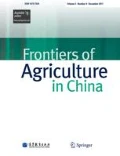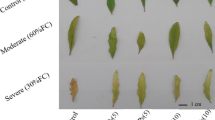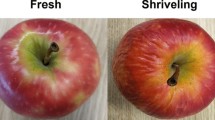Abstract
The postharvest physiology of strawberry was investigated to study the effects of ozone on weight loss rate, ascorbic acid, respiration rate, peroxdase (POD) activity, catalase (CAT) activity, and malondialdehyde (MDA) content during cold storage. The strawberries were treated with ozone of 0 ppm (control), 2 ppm, 4 ppm, and 8 ppm, respectively. The results indicated that the treatment of 4 ppm ozone could inhibited the decrease of ascorbic acid, POD activity, and CAT activity, and reduced weight loss rate and MDA content. The treatment delayed the senescence of strawberry, with a significantly lower respiration rate. Thus, the best concentration of ozone was 4 ppm, and ozone treatment could be a good candidate for maintaining postharvest quality of strawberry and provide a longer storage life.
Similar content being viewed by others
References
Aebi H (1984). Catalase in vitro. Methods Enzymol, 105: 121–126
Bao Q B, Liu J W (2004). Effects of pre-cooling conditions on qualities of strawberry with different maturity levels. Food Science and Technology, 8: 77–81
Cao S F, Hu Z C, Pang B (2010). Optimization of postharvest ultrasonic treatment of strawberry fruit. Postharvest Biology and Technology, 55(3): 150–153
Cong J M (2008). Research of application of nisin in preservation of strawberry. Food and Machinery, 24(2): 131–133 (in Chinese)
EPRI (Electric Power Research Institute) (1997). “expert panel” U.S. Food and Drug Administration, 1997. Substances generally recognized as safe, proposed rule. Federal Register, 62(74): 18937–18964
Forney C F (2003). Postharvest response of horticultural products to ozone In: Hodges D M, ed. Postharvest Oxidative Stress in Horticultural Crops. Binghamton: Food Products Press, 13–53
Gabler F M, Smilanick J L, Mansour MF, Karaca H (2010). Influence of fumigation with high concentrations of ozone gas on postharvest gray mold and fungicide residues on table grapes. Postharvest Biology and Technology, 55(2): 85–90
Graham D M, Pariza M, Glaze W H, Newell G W, Erdman J W, Borzelleca J F (1997). Use of ozone for food preservation. Food Technol, 51(6): 72–76
Kalir A, Ornri G, Poljakoff-Mayber A (1984). Peroxidase and catalase activity in leaves of Halimione portulacoides exposed to salinity. Physiologia Plantarum, 62(2): 238–244
Kays S J (1991). Postharvest Physiology of Perishable Plant Products. New York: Van Nostrand Reinhold
Kim J Y, Kim H J, Lim G O, Jang S A, Song K B (2010). The effects of aqueous chlorine dioxide or fumaric acid treatment combined with UV-C on postharvest quality of ‘Maehyangs’ strawberries. Postharvest Biology Technology, 56(3): 254–256.
Kim J G, Yousef A E, Dave S (1999). Application of ozone for enhancing the microbiological safety and quality of foods: a review. J Food Protect, 62(1): 1071–1087
Li X Z, Zheng T S, Zhang X M (2006). Study on effect of 1-MCP of different concentrations on fresh-keeping of strawberry fruit. Food Science, 27: 513–516
Nickols D, Varas A J (1992). Ozonation. In: Bryant E A, Fulton G P, Budd G C, eds. Disinfection Alternatives for Safe Drinking Water. New York: Van Nostrand Reinhold, 197–258
Qian Y M, Gao L P, Zhang Y Q, Gao G Z, Xu D C, Yuan WF, Guo Z H (2006). Effects of low temperature treatment on postharvest strawberry fruit quality. Journal of Anhui Agricultural University, 33(2): 268–271 (in Chinese)
Razumovski S D, Zaikov G E (1984). Ozone and Its Reactions with Organic Compounds. Amsterdam: Elsevier Science
Washington W S, Shanmuganathan N, Forbes C (1992). Fungicidal control of strawberry fruit rots, and field occurrence of resistance of botrytis cinerea to iprodione, benomyl and dichlouanid. Crop Prot, 11(4): 355–360
White G C (1999). Ozone in: Handbook of Chlorination and Alternative Disinfectants. 4th ed. New York: Van Nostrand Reinhold, 1203–1261
Wills R B H, Kim G H (1995). Effect of ethylene on postharvest life of strawberries. Postharvest Biology and Technology, 6(3): 249–255
Yang Y H, Kang Z L (2006). Effect of chitosan and vitamine C mixture on strawberry fresh-keeping. Acta Agriculturae Boreali-occidentalis Sinica, 15(2): 131–133 (in Chinese)
Zhao S J, Xu C C, Zou Q, Meng Q W (1994). Improvements of the method for measurement of malondialdehyde in plant tissue. Plant Physiology Communications, 30: 207–210
Author information
Authors and Affiliations
Corresponding author
About this article
Cite this article
Zhang, X., Zhang, Z., Wang, L. et al. Impact of ozone on quality of strawberry during cold storage. Front. Agric. China 5, 356–360 (2011). https://doi.org/10.1007/s11703-011-1053-y
Received:
Accepted:
Published:
Issue Date:
DOI: https://doi.org/10.1007/s11703-011-1053-y




